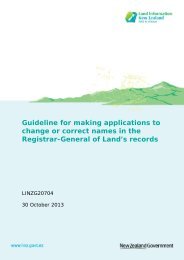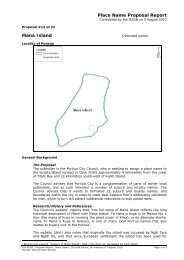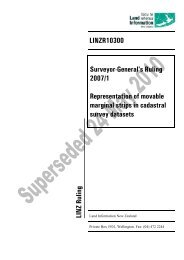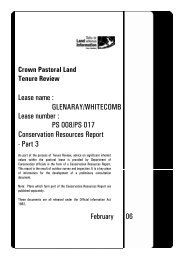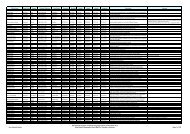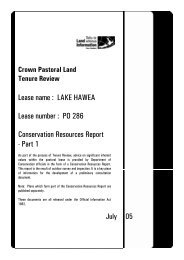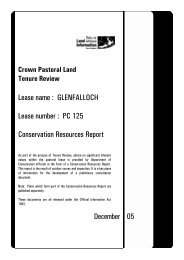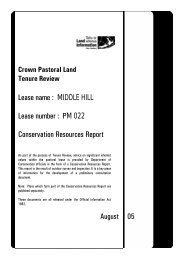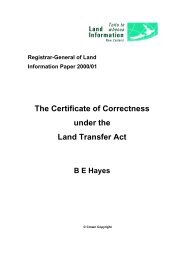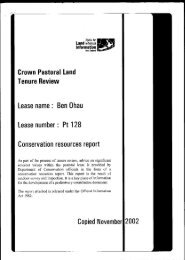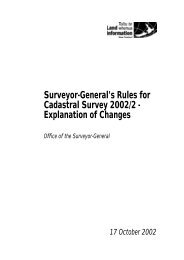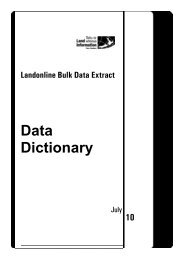Part 1 - Land Information New Zealand
Part 1 - Land Information New Zealand
Part 1 - Land Information New Zealand
Create successful ePaper yourself
Turn your PDF publications into a flip-book with our unique Google optimized e-Paper software.
RELEASED UNDER THE OFFICIAL INFORMATION ACT<br />
Alpine fescue tussockland (Festuca mathewsii subsp. pisamontis) is the major community across<br />
much of the gently rolling summit plateau and has been induced from a formerly more extensive<br />
snow tussockland as a consequence of burning and grazing. The community is often codominated<br />
by blue tussock and alpine fescue with a range of intertussock herbs that include<br />
golden speargrass, false speargrass (Celmisia lyallii), Lycopodium fastigiatum, Pentachondra<br />
pumila, Scleranthus uniflorus, snowberry (Gaultheria depressa), Raoulia subsericea, Pimelea<br />
oreophila, Leptinella pectinata and sweet vernal.<br />
Narrow-leaved snow tussock and slim snow tussock (Chionochloa macra) are both present in<br />
fragmented patches within the matrix of alpine fescue tussockland. Snow tussocklands are<br />
strongest on shady aspects or in shallow depressions and valley heads. They share many of the<br />
same intertussock species as described for alpine fescue tussockland. Locally some tall snow<br />
tussocks are heavily browsed by stock.<br />
Low shrubland dominated by Dracophyllum pronum occurs on many south-facing gravelly slopes<br />
and exposed ridge crests. Associated species include alpine fescue tussock, cottonwood<br />
(Ozothamnus vauvilliersii), patotara, Kelleria dieffenbachii, Anisotome flexuosa, Craspedia<br />
incana, Luzula pumila, Brachyglottis bellidioides and Euphrasia zelandica.<br />
The many and varied alpine rock tors and outcrops support a range of plants that are uncommon<br />
elsewhere on the PL. These include necklace fern (Asplenium flabellifolium), bladder fern<br />
(Cystopteris tasmanica), Jersey fern (Anogramma leptophylla), Blechnum vulcanicum,<br />
Pachycladon cheesemanii, Koeleria novozelandica, Anisotome cauticola, Senecio dunedinensis<br />
and Gingidia decipiens.<br />
Although not a major feature of the PL, several alpine fen wetlands occur in the head of streams<br />
and creeks within the unit. These small areas have high species diversity including several species<br />
that are nationally uncommon. Most are dominated by sedges; either comb sedge (Oreobolus<br />
pectinata) or Carex gaudichaudiana but with a large range of prostrate herbs including Caltha<br />
obtusa, Gaultheria parvula, Platango triandra, Euchiton lateralis, Coprosma perpusilla,<br />
Leptinella “seep”, Schizeilema cockaynei and Ranunculus gracilipes. Nationally uncommon<br />
herbs in these wetlands include Ranunculus maculatus, Plantago obconica, and Euchiton<br />
polylepis. Fens at the head of creeks that drain into the lower Roaring Meg show signs of heavy<br />
use and browsing by sheep with discarded comb sedge tufts littering the surface of the fens.<br />
Other wetland types are also present. An unusual periodically wet gravelfield near Mt Michael<br />
has a population of the threatened herb Crassula multicaulis. (see Photo 5, Section 4.3). There are<br />
also occasional small cushion bogs on the gentle ridge crest north of Mt Michael. While sharing<br />
many of the same species as fens they also have species tolerant of low nutrient status associated<br />
with such areas including Abrotanella caespitosa and Ranunculus maculatus.<br />
Lowburn Faces<br />
This unit runs from the Low Burn valley floor and homestead westwards up steep slopes until<br />
these transition to the easier terrain of the Summit Plateau (c. 1200 m). It includes the lower and<br />
middle reaches of the Lowburn and its named tributaries; Tongue Spur Creek, Pennycocks Creek,<br />
and Rose Creek.<br />
The lowermost toeslopes are mostly in developed pasture although very small pockets of native<br />
shrubs still occur on steeps slopes or around rock outcrops. Low hill slopes on the true left of the<br />
Low Burn at c. 350 m support a predominantly native shrubland of surprising diversity, despite<br />
10



